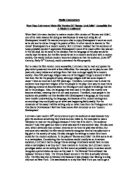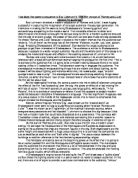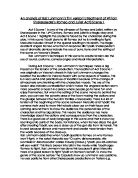Moreover, Baz Luhrmann creates a dramatic fight scene through the ways he uses different camera angles and shots in the scene. The first shot in the scene is an establishing shot, wide-angle long-shot from the top of the lifeguard’s chair, where Benvolio is situated. This shot portrays Benvolio as if he is omniscient, as if he is watching over the scene like a god. This omniscient behaviour is further portrayed when a close up zooms into Benvolio’s face as he makes his “mad blood stirring” speech, in order to focus on what Benvolio is saying, forewarning the audience of events to come. During this shot Benvolio looks worried, with a dark grey storm in the background, as if the storm is heading towards the Montagues. Baz Luhrmann creates a dramatic fight scene through the ways he portrays the Capulets in this scene. As the Capulets walk towards the Montagues in a line, they are portrayed first as a mid-shot of each Capulet and then close-ups of Tybalt and Benvolio. The mid-shot conveys the intimidating attitude of the Capulets, thus conveying their intentions to threaten the Montagues. The camera switches close-up shots, first of Tybalt’s aggressive expression, then to Benvolio’s worried expression, presenting the reactions of the two main characters in these shots.
Equally, Baz Luhrmann creates a dramatic fight scene through his use of camera angles to portray Romeo and Tybalt during the fight. Romeo comes out of his car excited after his marriage to Juliet, but is unaware of the Capulet’s presence. As Tybalt shouts “Romeo!” Romeo stops, looking worried as a close up zooms in onto him, displaying the desperation on Romeo’s face and to be taken seriously, as he means no harm to Tybalt. When Romeo refuses to fight Tybalt, Romeo falls on his knees and Luhrmann uses an overhead high angle shot to convey Romeo’s submissive position and follows this with a low angle shot of Tybalt to show his dominance. This effectively conveys the power struggle between the two families, creating tension and drama. Also, the close-ups of the characters demonstrate the emotions and emphasises the significance of Romeo’s words “Be satisfied”. This displays how Luhrmann’s use of various camera angles effectively portrays a dramatic fight scene through how they reinforce the emotions of the protagonist.
Finally, Baz Luhrmann creates a dramatic fight scene through the ways he portrays Romeo after he kills Tybalt at the end of the scene. After Romeo shoots Tybalt, the camera cuts to a close-up of Romeo’s shocked face, conveying the fact that he has realised that this latest slaughter of Tybalt could determine the downfall of his relationship with Juliet. This is also depicted by the quick cut to Juliet just as Romeo shot Tybalt, which suggests that just like Romeo’s expression the new bond between the Montague and the Capulet could be short lived. After the underlying close-up of Romeo’s face, the camera reverts to a wide-angle crane-shot which shows the murder scene of Tybalt from the perspective of the statue of Jesus. This shot suggests that Romeo is small compared to the statue, which resembles the power of the gods in this dramatic scene. In Shakespearian times gods were thought to have power over men’s lives, which is depicted in this scene, especially after Romeo shouts, “I am fortune’s fool”. This conveys how this shot personifies the powers of the supernatural, in the sense that Romeo appears to give himself up as their “fool”, thus creating contrast to produce an effective fight scene. Overall, due to the emphasis of emotions and expressions, Luhrmann’s use of camera angles creates a dramatic fight scene.
Baz Luhrmann creates a dramatic fight scene through the ways he uses different special effects and editing in this scene. In the contrasting scene of Juliet, between the two action scenes, the background is serene, in contrast to the dark and dramatic background and action in the previous scene and the next scene. This relaxing scene, therefore, provides a release of tension for the audience. The use of dramatic irony in this scene, as Juliet has no idea that Mercutio is dead and Romeo has just slain Tybalt, presents to the audience that they know more than she does and that they realise the rebellious immature behaviour of Romeo as he anguishes revenge for his friend’s death, whereas Juliet does not.
Moreover, Luhrmann creates a dramatic fight scene through the use of special effects and editing in the most pivotal moments in the final fight scene to make it as dramatic as possible. One example of this attempt is the blurring effect on Romeo as he and Tybalt crash each other’s cars, which creates a focus on Romeo’s emotions, as his future could be unclear due to the unstable focus of this shot. Also, there was a crack of thunder after Romeo killed Tybalt, which indicates that the heavens are angry at the murder that Romeo has just committed. The rain indicates the weeping of the gods after another perilous feud. The use of blurred camera shots and effects creates a dramatic fight scene as it creates a sense of uncertainty as to what will happen when the cars collide, which adds more drama to such a pivotal scene in the film.
Finally, Luhrmann creates a dramatic fight scene through the ways he uses various soundtracks within this scene. An example of the use of soundtrack is the Requiem Mass used during Mercutio’s death. This choral piece is sung during a funeral, which reflects the fact that Mercutio has just been slain by Tybalt. The choral notes are intense and sad, therefore justifies the death of an innocent friend who was not a member of one of the feuding families, displaying the injustice the audience is experiencing. The music builds a crescendo as the scene nears to its end, building up the tension created as Mercutio uttered “A plague on both your houses”. As Mercutio is not a member of either family, this provokes an emotional reprise in the audience because the absence of relations draws the audience into the film, creating a more dramatic fight scene. Also, Luhrmann uses an intense soundtrack during the chase scene between Romeo and Tybalt. In this scene, Luhrmann uses diagetic sounds of the two car’s engines. This emphasises the tension between the two drivers, Romeo and Tybalt, and the anger of Romeo as he seeks revenge for the death of Mercutio. The sound of the cars crashing further creates an experience of rage and intensity for the audience. These diagetic sounds convey how effectively dramatic this scene is. Lastly, there is an absence of soundtrack after Romeo kills Tybalt. Baz Luhrmann does not add a soundtrack in this scene because this is to make the audience realise the gravity of the consequences that face Romeo after he kills Tybalt in a consequential brawl. This raises the tension within the audience, as they also realise the mistake Romeo has just committed to and so they feel sorry for Romeo for his immature behaviour of a tragic hero.
In conclusion, the music, camera angles, special effects and presentation of characters creates a dramatic fight scene in the Baz Luhrmann version of Romeo and Juliet. The camera angles are effective in the sense that they display the viewpoints and the expressions of each character as the film progresses, such as the worried expression of Benvolio as he delivers his “mad blood stirring” speech, which conveys a worried feeling to the audience. The costumes further express the behaviour of the characters, such as Benvolio’s unbuttoned Hawaiian shirt, presenting a sense of rebellious but innocent attitude, conveying to the audience that they are typical young men, immature but can look after themselves. The various special effects used create tension upon the drama that has been acted, such as the crack of thunder after the killing of Tybalt, which indicates that the heavens are angry at the death that Romeo has just committed, therefore the audience feels sorry for the immature behaviour of the tragic hero. Finally, the soundtrack further creates tension upon the drama that has been acted, such as the diagetic sounds of the car’s engine and the crash, which emphasises the tension between the two drivers, Romeo and Tybalt, and the anger of Romeo as he seeks revenge for the death of Mercutio. The sound of the cars crashing further creates an experience of rage and intensity for the audience.








